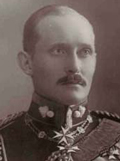 |
Arthur Frederick Patrick Albert
b. 13 Jan 1883, Windsor, England, U.K.
d. 12 Sep 1938, London, England, U.K. |
| Title: |
Governor-General and Commander-in-Chief in and over the Union of South Africa ::
Goeverneur-generaal en Opperbevelhebber in en over de Unie van Zuid-Afrika |
| Term: |
20 Nov 1920 - 21 Jan 1924 |
| Chronology: |
5 Aug 1920,
appointed by Commission under the Royal Sign Manual and Signet [1] |
| |
20 Nov 1920, took an oath of allegiance and an oath of office as Governor-General and Commander-in-Chief of the Union of South Africa, Union Buildings, Pretoria [2] |
| |
21 Jan 1924,
appointment superseded by the Commission of a successor effective on taking the prescribed oaths (21 Jan 1924) [3][4] |
| Names/titles: |
Baptised: Arthur Frederick Patrick Albert (16 Feb 1883); nobility title (by birth): Prince Arthur Arthur Frederick Patrick Albert of Connaught; family and dynastic name Windsor established by the Royal Proclamation of 17 Jul 1917 |
| Biography: |
| The only son and second child of Prince Arthur William Patrick Albert, Duke of Connaught and Strathearn (the third son of Queen Victoria); was the first royal prince to be educated at Eton; attended the Royal Military College at Sandhurst; commissioned second lieutenant in the 7th Hussars (1901), in time to serve in South Africa; spent several months stationed at Krugersdorp; promoted to lieutenant (1903), captain (1907); introduced as a member of the UK Privy Council (11 Jun 1910); appointed (10 Nov 1911) a Counsellor of State, performing royal functions during periods of the King's absence abroad; brevetted to major (1913); substantive promotion to major followed in 1915; during World War I, he served as aide-de-camp to Generals Sir John French and Sir Douglas Haig, the successive commanders of the British Expeditionary Force in France and Belgium; brevetted lieutenant-colonel (1919); became the honorary Colonel-in-Chief of the 2nd Dragoons (Royal Scots Greys) in 1920; became a colonel in the reserves in 1922; promoted to the honorary rank of major general (1922) and became an aide-de-camp to his first cousin, King George V; during the period 1906-1918 he represented the British kings on various occasions in Portugal, Russia, Bavaria, Italy and Japan; after receiving the appointments as Governor-General and Commander-in-Chief of the Union of South Africa and High Commissioner for South Africa, he landed in Cape Town 17 Nov 1920, taking office in Pretoria 20 Nov 1920; visited all parts of South Africa, Rhodesia, the High Commission territories and South-West Africa; rejected a Natal ordinance of 1921 depriving Indians of the municipal franchise; other important events of his administration included the Rand Rebellion (1922) and the Southern Rhodesian rejection of incorporation within the Union of South Africa; sailed for Europe from Durban 10 Dec 1923; upon returning to Great Britain, he became involved in a number of charitable organizations, including serving as chairman of the board of directors of Middlesex Hospital. |
| Biographical sources: "Dictionary of South African Biography", ed. by W.J. de Kock, D.W. Krüger (et al.) (Pretoria: Nasional Boekhandel Bpk. for National Council for Social Research, Dept. of Higher Education, 1968-1987), 5 vols; The Times, No. 48,097, Royal Edition, 12 Sep 1938, pp. 12, 14 (obituary). |
| |
| [1] |
Government Gazette, No. 1106, Extra, 23 Nov 1920, pp. (425)-426. |
| [2] |
Government Gazette, No. 1106, Extra, 23 Nov 1920, p. (425). |
| [3] |
Government Gazette, No. 1363, Extra, 23 Jan 1924, p. ii. |
| [4] |
After Prince Arthur of Connaught permanently left South Africa, his functions were taken over by Sir James Rose-Innes as Officer Administering the Government of the Union of South Africa :: Ambtenaar belast met de Regering van de Unie van Zuid-Afrika (11 Dec 1923 - 21 Jan 1924) who continued in office until the installation of Earl of Athlone. |

